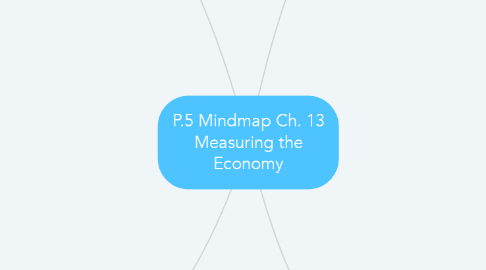P.5 Mindmap Ch. 13 Measuring the Economy
by Ricky Grimm

1. 13.4) What does the inflation rate reveal about an economy's health?
1.1. Inflation of any amount exacts economic costs.
1.2. Over time, technological advances may improve the quality or add to the lifetime of a product.
1.3. Consumers pay normal costs with nominal wages, or wages based on current prices.
1.4. The cost in current dollars of all the basic goods and services that people need is the normal cost of living.
1.5. Inflation rate: The percentage increase in the average price level of goods and services from one month or year to the next.
1.6. Real cost of living: The nominall cost of basic goods and services, adjusted for inflation
2. 13.5) How does the business cycle relate to economic health?
2.1. Business cycles are irregular in both length and severity, this makes peaks and troughs difficult to predict.
2.2. On rare occasions, a recession will last a long time and cause serious damage to the economy.
2.3. Booms will turn to busts. the bust, or contract-iron phase of the business cycle, is also called a downturn, a downswing, or a recession.
2.4. 1
2.5. Recession: A decline in economic activity lasting at least six months.
2.6. Inventory: Merchandise that companies or stores have on hand.
3. 13.2) How do economists measure the size of the economy?
3.1. The main measure of the size of a nation's economy is its gross domestic product. GDP is an economic indicator that measures a country's total economic output.
3.2. Economists use GDP figures to determine not only how big an economy is, but whether it is growing or shrinking and at what rate.
3.3. to compensate for the effects of inflation, the Commerce Department calculates what is called real GDP. Real GDP measures the output of an economy not in current dollars, but in constant dollars.
3.4. As a country's per capital GDP increases, so too do other indicators of well-being.
3.5. Current dollars: reflects the purchasing power of the dollar in the year they are spent.
3.6. Constant dollars: is fixed at a rate that was current in a specified base year.
3.7. Literacy rate: the percentage of people in these countries who can read and write.
4. 13.3) What does the unemployment rate tell us about an economy's health?
4.1. Like the GDP, the unemployment rate is a useful indicator of the health of an economy.
4.2. If a nation has a high unemployment rate, that means that the overall health of the economy is bad.
4.3. Employed: Members of the labor force who have jobs Unemployed: Members of the labor force who are jobless, but are looking for work. Not in labor force: Everyone who is eligible to be in the labor force but is neither working nor looking for work.
4.4. 1) Main cost of high unemployment is lost potential output. 2)Unemployed workers also pay a serious economic cost. 3)High unemployment is also costly for society at a large.
4.5. Seasonal unemployment: occurs when a businesses shut down or slow down for part of the year, often because of weather
4.6. Like everything, economies will go through good times and bad. This will be reflected in the unemployment, but it is more of a matter on how they can rebound from a bad time.


